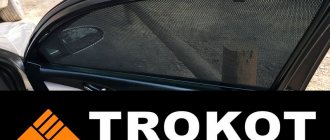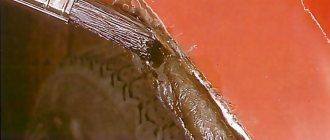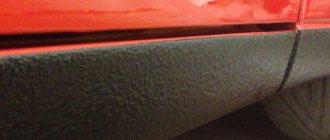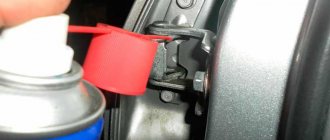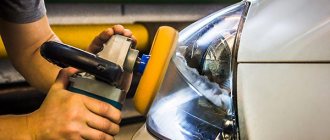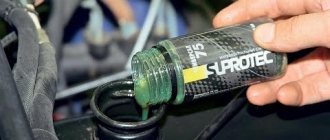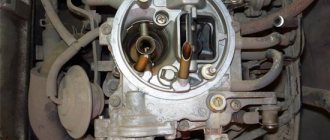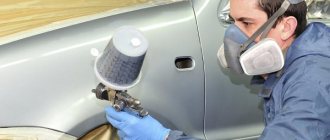Not everyone can afford to buy a new car and change the car every 3-5 years. And the older a car gets, the more rust it forms. That’s why today I decided to talk to you about the rust converter. This is a special composition that is used to treat corroded surfaces.
The base is made of potent substances that react with iron oxide (rust) and destroy its structure. This creates a protective layer and prevents further spread of these red marks on the metal.
Which rust converter is best for cars?
Tsinkar is not used for galvanized bodies. It itself forms a protective film of zinc on the metal and its use will be useless. It is worth covering parts made of thin sheet metal with a zinc solution. This is the best method of protecting them from corrosion. The most practical is an acid modifier. At a low price, such a converter removes rust well.
Good soil chemicals have not yet been produced in Russia. Typically, drivers use foreign products.
When choosing a rust modifier, take into account the thickness of the corrosion layer. If it is more than 100 microns, no converter can handle it.
The best rust converters for cars are produced under the following brands:
- Feno.
- Hotex k converters.
- Ferrisol is used for routine cleaning of metal surfaces from corrosion.
- Permatex.
- Sonax.
When choosing a product, you can contact the nearest service station that provides car painting services. They will tell you which modifier to choose specifically for your car model. When choosing a converter, consult with car owners who have performed similar work on their car.
How to choose a good rust converter
When fighting corrosion, you should not delay the treatment of products for a long time, otherwise the outbreak will greatly increase. It is much easier to choose a converter that can easily remove small elements than one that can dissolve a thick layer of rust. Before purchasing, it is important to evaluate the type of surface: for horizontal bases, cheaper compositions with a liquid texture are suitable; for inclined and vertical bases, you should buy paste or gel products.
If rust has already formed on the metal, the best converter for it will be acidic or neutral. Liquids with zinc are ideal for preventing rust, especially when it comes to car parts. For hard-to-reach places, it is recommended to choose formulations in aerosol form with a long nozzle, or use spray bottles with special tips.
In general, a high-quality rust converter will be characterized by the following properties:
- defect removal efficiency;
- deep penetration;
- safety for the base;
- no toxicity;
- speed of action;
- economical consumption;
- ease of application;
- sufficient duration of action.
The best rust converters in the form of a jar solution
ASTROhim
The composition from the domestic company ASTROhim has a variety of release forms: solutions in jars, aerosols. But, firstly, spray packaging is much less available on sale, which means it is more difficult to find. Secondly, the cost for a larger jar (500 ml) is not much higher than the price for an aerosol bottle, which is half the size (250 ml). Both of these points influenced the rust converter in question to take its place in this category.
You can purchase the ASTROhim modifier for very little money. Such cheapness does not mean that the drug is inferior in quality and effectiveness to more expensive competitors. Although the manufacturer claims the content of zinc ions, this converter is quite classic.
It is based on an active substance - phosphoric acid, under the influence of which the corrosive layer is destroyed. After applying the product with a brush and removing the rust with a special napkin, a film forms on the surface. It provides excellent adhesion, so ASTROhim can also be applied to bare metal as additional protection before painting.
Advantages:
- copes well with its main task;
- the most affordable price.
Flaws:
- the need for thorough rinsing.
Phenom
Another Russian manufacturer, the Fenom company, presents to customers a rust converter in the form of a jar solution. The product is sold in very small tubes, with a volume of only 0.11 liters. Considering such a small amount of product, it becomes clear that to clean a large area of corrosion you will have to buy several cans, which means that all the original cheapness disappears.
The presented modifier is suitable for both rust control and primary metal processing. It provides excellent adhesion of paint and primer to the surface, as well as long-term protection against corrosion for 5-7 years. The speed of reaction of the composition on a rusted area is amazing. Perhaps Fenom is able to clean the damaged area the fastest, turning the red coating into a dark, hard crust of soil.
Advantages:
- speed of reaction;
- no rinsing required;
- forms a ferromanganese film on the surface;
- long-term protection against corrosion.
Flaws:
- for a large number of works it is necessary to purchase many tubes;
- Overpriced for such a small volume.
Permatex 81773
Permatex 81773 is a modifier that provides one-stage metal processing. The product gets rid of rust quite quickly. In just a few minutes it transforms it into a black polymer and durable coating, ready for subsequent paint application. It is an excellent primer that guarantees protection against the recurrence of corrosion. The converter is sold in 454-gram cans. It is noteworthy that the existing volume is enough for a large number of works.
Permatex 81773 can be used with fiberglass and putty as it was specially developed for this purpose. The preparation is applied with a brush, evenly distributed over the surface. Temperature indicators for the permissibility of work range from 10 to 32 degrees, while the metal should not be heated above 93 degrees. The product ideally destroys rust on parts of agricultural, technical, automotive and other equipment.
Advantages:
- transformation of the corrosive layer in a few minutes;
- single-stage processing;
- can be used as a primer.
We recommend: After washing the engine does not start. What to do?
Flaws:
- Not suitable for use on external metal surfaces of the vehicle.
Types of rust converters
The entire category of rust converters can be divided into 2 broad groups:
- Acid-free (coloring)
- Acidic (rust removing)
- The simplest are acid-free converters . tannin- based rust converters . This is an organic compound that neutralizes rust , transforming it into a water-repellent protective film.
There are also converters based on organic polymers, such as butoxyethanol and ethylene glycol monobutyl ether . The principle of operation of acid-free converters is the same; rust turns into a protective film .
Many acid-free rust converters are used as primer paints. Such products contain an ordinary primer. Combined acid-free converters allow you to save a lot of time, effort and financial resources on creating a protective layer, because 2 tasks are solved at once: fighting rust and creating a layer of paintwork .
Some of the coloring converters still contain a small percentage of organic or inorganic acids . By acidifying the environment and reducing the alkaline pH balance, the chemical processes of rust conversion are accelerated.
- More complex and expensive are acid converters , which have an excellent cleaning effect . Rust converters based on orthophosphoric acid are widely used . But rust-removing converters can be based on many other acids: hydrochloric, nitric, sulfuric and even citric and acetic.
Acid converters have a complex effect on rusting metal. Thanks to acid, rust is corroded . Additionally, such converters leave a thin, durable protective film . The creation of a protective film is due to the presence of passivators in acid converters. The most widespread among passivators are oxides of zinc and manganese .
corrosion inhibitors are often added to acid converters . Multi-component rust converters are called “reinforced” . Products such as Poliform Red, Metal Rescue, Eastwood Rust Dissolver, etc. are widely used among enhanced rust converters.
What are the different types of acid-free rust converters?
How to use an acid-free converter
This type of rust converter involves interaction with well-cleaned metal . That is, corroded surfaces need to:
- Remove rust
- Degrease
- Dry
Typically, acid-free converters are applied with a paint brush . There is no need to use any special precautions when working with this type of converter.
The converter is applied to the metal in a thin, uniform layer. After this, the applied protective layer must be dried . The ideal option is drying in a special chamber. But many craftsmen dry the treated surfaces simply with an industrial hair dryer . If there is neither a drying chamber nor a hairdryer, then the treated metal surfaces are simply allowed to stand for 1-2 days.
Paint or varnish is usually applied over the newly created protective layer .
What are the different types of acid-based rust converters?
How to use an acid converter
Working with acidic environments places increased safety requirements . When using an acid converter, you should use: safety glasses, a respirator, gloves and a gown with a high class of chemical protection.
The acid converter can be applied to metal surfaces without prior cleaning to prevent corrosion . When interacting with rust, the acid converter will begin to foam. This is a good sign. The converter is applied either by brush or by spray. The application method depends entirely on the type of acid converter.
The applied converter should be given some time to cure. As a rule, the converter is kept for 10-20 minutes . In this case, you need to ensure that the acidic medium does not thicken. If the converter begins to thicken, it is recommended to dilute it with a new portion of the converter.
After a short period of time, the remaining acid converter should be wiped off well and dried . The recommended drying temperature is 50˚C.
Experienced craftsmen are of the opinion that to obtain a good result, the metal surface needs to be processed 2-3 times. Next, the surfaces treated with an acidic rust converter must be painted or varnished.
What to remember about rust
If we talk about corrosion, then you should remember that:
- after rust occurs, this defect spreads very quickly;
- If you simply cover up the damaged surface, then corrosion will continue to develop, it will just go unnoticed until a certain point.
It is also necessary to understand that corrosion is easier to prevent than to fight it. To protect the body of your vehicle, you should constantly clean the surface of the car from water. In addition, it is necessary to use special compounds. But if corrosion has already occurred, you should resort to rust converters for cars. This substance guarantees high-quality protection of metal elements, since it forms a special film that does not allow moisture and oxygen to pass through. Any product contains a number of acids that will interact with corrosion.
The most common are compositions based on orthophosphoric acid or zinc salts. They corrode rust, while being harmless to the metal surface. In addition to acids, among the ingredients of converters you can find a number of other elements that form a special protective layer on the surface. Among the most popular supplements are:
- rust inhibitors. They prevent the reoccurrence of corrosion over a long period;
- thickeners With their help, surface treatment is facilitated, and the substance will not flow onto the ground;
- additional active substances. Improves the protective layer. As a rule, their use leads to the appearance of a rough film on the surface.
Video advice on which rust converter is better:
Rating of the best rust converters
| Nomination | place | Name of product | price |
| The Best Aerosol Rust Converters | 1 | Liqui Moly "Pro-Line Schnell-Rostloser" | 590 ₽ |
| 2 | Hi-Gear | 690 ₽ | |
| 3 | Autoprofi | 135 ₽ | |
| Best Liquid Rust Converters | 1 | Astrohim with active zinc ions | 141 ₽ |
| 2 | Phenom | 157 ₽ | |
| The best gel rust converters | 1 | Permatex 81773 | 723 ₽ |
| 2 | Kudo KV-70005 | 104 ₽ |
How can I replace a rust converter?
If you are good at chemistry, you can mix phosphoric acid with 2-butoxyethanol. These substances can be obtained at any chemical store. However, a rust converter is the most effective rust control product. Ideally, you should seal, paint or treat the metal after you have applied the rust converter and it has cured. However, there are some brands that advertise that their rust converter will protect against future corrosion in the absence of further treatment.
The advantage of factory-made products is that some of the converters are significantly more durable than home-made products. Although it is not a standard for measuring durability, more viscous rust converters tend to be more durable than their thinner competitors. However, individual formulas can weigh just as heavily in this regard once all the rust has been converted - regardless of the initial thickness of the product.
TOP 5 converters
Among the best converter manufacturers are companies from Russia and America. They are the ones who make up the symbolic rating of the TOP 5 anti-corrosion products:
Tsinkar. Release form - paste, spray or liquid with a volume of 0.5-1.5 liters. The advantages include high reliability and low price of the product. Manganese, which is part of the drug, enhances the effect of the main components. The only drawback is that processing takes a long time.
Chain mail. Another representative of Russia on our list. It costs a little more than Tsinkar. Most often used as a preparatory stage before covering the car body with paint and varnish material.
Hi-Gear. This guest from America comes in the form of an aerosol, the capacity of the can is 370 g. Allows processing at high speed, suitable for application to hard-to-reach areas.
The characteristics of the product remain unchanged, even under conditions of temperature changes. The downside is that the cost is slightly higher than that of other converters (cylinder price starts from 350 rubles).
Autoprofi. Release form: spray bottle with selectable jet pressure. Packaging – 500 ml. The attractive price and good effect make the product very popular. According to the manufacturer, the product does not require rinsing; it is enough to wipe the metal after finishing work.
Feno. Advantages of the product: compact size (0.11 l), long-lasting effect (protection after treatment for up to 5 years), does not require rinsing. For a large area of work, you need to stock up on several packages.
Main characteristics
Everything looks quite simple and promising. I can't say which converter is better. Each of them has its own characteristics, different acids are used, and they are suitable for different cars.
Here you need to proceed from what suits you specifically. Instructions for use are on all packages, as well as recommendations from the manufacturer. So lean on them.
I want to talk about what these drugs are, how to use them and whether it is worth buying something like this at all.
Let's start with the main characteristics.
- Repeated tests have shown that the optimal result for a car or for metal structures (they can be used not only for car repairs) can be achieved if the rust thickness does not exceed 100 microns. Although some bottles indicate that they can handle thicknesses of up to 400 microns. Reviews on this matter are contradictory, but if the procedure is carried out correctly and a high-quality composition is used, I think this is possible;
- The bulk of the products that serve to protect against corrosion and remove it before painting use acids. This is mainly orthophosphoric acid;
- There are also those who produce neutral type converters. These are products that contain tannin. They work well and are considered safer;
- The composition may include polybasic acids and hydroxycarboxylic acid. Many people call one-component formulations weak, but in fact they sometimes work much better than multi-component analogues;
- The biocide, inhibitor and pigments serve as substances to create a protective film;
- Mixtures containing manganese and zinc salts are considered good. These are additional additives. A striking example of the effectiveness of such solutions is the Tsinkar converter.
Here, I hope, everything is clear. I will not go into details of physical and chemical processes and tell how oxidation, reactions, transformations, etc. occur. You don't need this. I advise you to understand what types of rust converters there are.
Types of rust modifiers
The industry produces rust converters for the following types of cars:
- Zinc. All zinc-based preparations are popular. The deposited layer of zinc on the car body prevents the recurrence of corrosion. Before performing the operation, the rusty surface is cleaned, sanded and treated with an electrolytic zinc solution. Experts note that the optimal time for applying a zinc rust converter is the moment a gray coating appears on the metal.
- Acidic. Such preparations prevent the development of corrosion at the initial stage. This is important because the car body is usually made of thin metal. If the rust process is started, the part quickly rots and through corrosion can form. As a result, expensive elements will have to be replaced. If a section of the body is coated with this modifier, a layer of corrosion simply will not form and the driver will not have to change the fender liners or hood cover over time.
- Converters of rust into soil. These are new generation modifiers. Unlike products produced on the basis of orthophosphoric acid, they do not create a protective layer on the metal, but convert rust into a primer. These primers are popular abroad, but in Russia, car enthusiasts tend to choose between products based on zinc or acids.
We recommend: Spare parts for MAZ-206 bus
The best aerosol rust converters
Hi-Gear
The American company Hi-Gear is popular among car service technicians and ordinary car enthusiasts. The auto chemical products of this brand have won the trust of both, so they can certainly be considered one of the best. The drug is sold in a 370 g can. Considering that one such bottle is not enough for a large number of treatments, we can say that the cost of the product is too high.
The packaging gives a powerful stream of modifier. There will be no problems with application to large areas, as well as with access to hard-to-reach places. When working, you should be careful; getting the substance on the paint can completely dissolve it. It is imperative to protect your eyes and respiratory tract while working to avoid serious burns. The manufacturer recommends applying the converter to the rusted area in several approaches, each time rinsing with alcohol. As a result, the corrosive layer will turn into a hard, dark surface that can be painted.
Advantages:
- powerful jet;
- long-term protection against re-corrosion;
- can serve as soil.
Flaws:
- need for washing;
- Overpriced for a can.
Autoprofi
Another Russian product in our selection, rust converter – Autoprofi. This modifier is not produced in a can, like the previous product, but in a trigger-type spray bottle. In this case, processing large surfaces becomes not so convenient. Sometimes drips may appear, which indicate that more of the drug is poured out than necessary, which means it is wasted. The package volume is 500 ml. The cheapness of this product is definitely good news.
The choice of different jets allows you to process a wide variety of surfaces. For example, a narrow and long one will reach the deepest hidden corrosion areas. The composition of the Autoprofi converter is based on the same orthophosphoric acid and a number of additives. The manufacturer indicates that upon completion, it is enough to simply wipe the surface without resorting to rinsing. But we still advise not to skip this stage. To better extinguish acid residues, you can add a little soda to the water.
Advantages:
- classic composition;
- quick removal of rust;
- preventing the emergence of new corrosion areas;
- ease of processing hard-to-reach places;
- price.
Flaws:
- without a remover, the paint may not adhere well;
- there are drips.
ABRO RC-1000
The American company ABRO presents its anti-rust product – RC-1000. The drug is packaged in classic cans, volume 283 g. The price is a little high, since among domestic analogues you can find cheaper and equally effective products. But despite this, this modifier is popular among consumers, so we could not help but note it.
The ABRO RC-1000 converter easily and quickly dissolves a layer of rust, modifying it into the soil. The protective moisture-resistant coating obtained as a result of the reaction improves metal adhesion. This matte, dark-colored layer firmly adheres paint materials to the surface and provides resistance to solvents. The treated surface is immediately ready for painting. To avoid drips, the manufacturer recommends applying the product in 2-3 thin layers, taking two-minute breaks between approaches.
Advantages:
- rapid modification of rust into the soil;
- after transformation, the surface is ready for painting;
- protects against under-film corrosion for a long time;
- no rinsing required;
- ease of application.
Flaws:
- There are cheaper domestic analogues.
What is a rust converter
Rust converter – oxidation neutralizer. This substance reacts with rust, converting it into a protective film. If in its free form rust acts as a moisture adsorbent, greatly accelerating corrosion processes, then when rust is neutralized, the oxidation process slows down significantly .
Additionally, the appearance of new foci of corrosion is prevented by a protective film, which is obtained from neutralized rust.
As a rule, a rust converter is not a panacea for corrosion . After all, the thin protective layer of the converter is quickly destroyed under the aggressive pressure of negative atmospheric influences. Sun, precipitation, heat and frost. All these factors negate the entire protective effect. For this reason, rust converters are used in conjunction with the creation of a protective paint layer .
It is worth noting separately that rust converters are not the only protective agents of this type. Along with converters, there are also so-called “corrosion inhibitors” and “passivators” . Inhibitors are compounds that affect the electrochemical potential of the steel surface (urea, sulfides, aldehydes, etc.). Passivators are galvanic or molecular coatings of zinc, copper, chromium, manganese and similar materials.
Inhibition and passivation are much more complex and expensive metal protection technologies. In many cases it is easier and cheaper to use a rust converter.
Today, many manufacturers of protective substances produce combination products. They contain an inhibitor, a passivator, and a converter.
Next we will talk about how to choose a rust converter.
How does a rust converter work?
Main varieties
If we talk about such means, then, first of all, we should highlight the following types:
- rust converter with zinc. At the moment, such substances are the most popular. They are characterized by almost instantaneous action and high efficiency. They offer increased protection against further rust. At the same time, before using them, you need to treat the surface with sandpaper, and then with a zinc solution. The product itself is used when the surface acquires a gray tint. It will take you longer than with other remedies, but it's worth it;
It may also be interesting: The alarm does not respond to the key fob, what should I do?
- acid agents. An old and proven method that is extremely useful and effective. The main advantage is simplicity and speed of use. We simply clean the area where rust has developed, and then apply the solution there. It is important to calculate the time correctly so as not to overexpose the product, but also not to eliminate it in advance. In general, here you need to follow the instructions;
- rust converter into soil. This is a fairly new modification that helps transform corrosion into soil. At the same time, according to reviews, the use of such solutions is not the safest idea, because the substance can damage the paintwork near the source of corrosion.
We recommend: How to fix a car battery yourself?
How to use a rust converter correctly
When treating a damaged area, pay attention to the depth of the corrosion. If it is more than 100 - 150 microns, the use of a converter is ineffective.
In this case, preliminary preparation in the form of mechanical finishing is needed.
As a rule, cleaning takes place in two stages. First, mechanical preparation is performed, and only then chemical surface treatment using converters.
Exact instructions for use are given in the instructions for the product, but the general algorithm of actions is as follows:
- Mechanical restoration. At this stage, it is necessary to remove pieces of rust using a wire brush or an angle grinder with a special wheel.
- Degreasing. To achieve the desired effect, it is recommended to use a solvent.
- Cleaning. Direct use of the rust converter, taking into account the instructions and release form.
- Surface treatment with water, if required.
- Degreasing. At this stage, the same solution is used as discussed above.
- Application of primer. The exception is when the converter prepares the surface for painting.
The sequence of actions may vary depending on the characteristics of the product used.
The Best Aerosol Rust Converters
Liqui Moly "Pro-Line Schnell-Rostloser"
Liqui Moly “Pro-Line Schnell-Rostloser” rust converter is an excellent product in all related senses. Despite the high cost (which is the only drawback), it is distinguished by its delicate and targeted effect on the area affected by metal corrosion, allowing full treatment to be carried out in a matter of minutes.
The mechanism of action of this solution combines the principles of WD-40 and the modifier we are used to: neutralizing rust, it cleans the moving joints (and makes it possible to unscrew them), and upon subsequent rinsing, forms a protective film on the surface.
The latter is the result of the action of filler materials, which include zinc ions. Liqui Moly “Pro-Line Schnell-Rostloser” is neutral to paint, and therefore does not pose the slightest danger to it. It can be applied even to contaminated surfaces - its excellent penetrating action will cope with both rust and dirt separation. In general, among other equals, this converter stands out favorably, thanks to which it takes a well-deserved first place.
Advantages
- neutral to paint, primer;
- high penetrating effect;
- a complex of additives ensures lubrication of moving parts and also wedges them (like WD-40);
- 400 milliliters volume;
- creating a durable film on the metal surface.
Flaws
- high price.
Hi-Gear
An expensive and very effective composition from the foreign company Hi-Gear, the main advantage of which is its targeted and rapid action even on deep pockets of corrosion. The powerful sprayer of the factory cylinder provides a jet output under significant pressure, due to which the already excellent penetrating ability of the modifier increases several times. The increased content of the active substance, which in this case is orthophosphoric acid, has an immediate destructive effect on iron oxides, turning them into polymer compounds of increased hardness.
True, for such a transformation, Hi-Gear must be washed off with alcohol - water will not ensure the proper removal of such a concentrated product. The only truly serious disadvantage of this converter lies in the extreme danger to the respiratory tract, skin and mucous membranes of humans. An increased concentration of acid also has a destructive effect on the paintwork, therefore, only a small drop of the product is enough to damage painted surfaces.
Advantages
- very effective action up to the destruction of the deepest areas of corrosion that are amenable to this type of maintenance;
- high penetrating ability;
- formation of a durable film when reacting with iron oxides;
- low consumption.
Flaws
- poses a danger to humans and has a destructive effect on paint;
- high price.
Autoprofi
The aerosol modifier from the Autoprofi company differs little in efficiency from its liquid counterpart (labeled “Galvanized”), but still contains several pleasant (and not so pleasant) nuances. As before, the product is characterized by a low price and a huge volume of the spray bottle: as much as 500 milliliters. The sprayer in this case is trigger, capable of operating in wide and narrow jet modes.
The first, as practice shows, is not effective - the fine suspension is not strong enough to overcome obstacles in the form of large pieces of rust and turns out to be suitable only for spraying local, lightly contaminated areas. The narrow jet, in turn, has a directional effect, being penetrating enough to affect even deep pockets of rust.
Another nuance that users point out is the poor adhesion of the aerosol to the paint. In this regard, before painting, the composition must be urgently completely removed from the surface, using a special remover. Otherwise, there is a risk of damage to the paintwork, which is especially unpleasant when processing a car body.
Advantages
- very low price;
- the ability to operate the spray gun in two spray modes;
- optimal bottle volume (500 ml);
- high penetrating ability of the composition.
Flaws
- the need for thorough washing before further processing of the product;
- poor adhesion.
The most suitable converter will depend on the nature of the rust work required. If you want a heavy-duty rust converter, then your best bet is Corroseal, which is one of the strongest and great for beginners. Speaking of primer, Skyco Ospho doesn't provide the absolute best rust-transforming performance, but it does serve as the best metal primer on our list—though that's the only category, other than price, where Ospho beat out Corroseal.
If you're looking for something less toxic, Evapo-Rust is biodegradable, non-flammable and non-toxic, although it is not actually a rust converter and cannot be used as a primer. However, Permatex uses formic acid, which, while not as effective as phosphoric acid rust converters, serves as a good halfway point between Evapo-Rust and the other products on our list.

